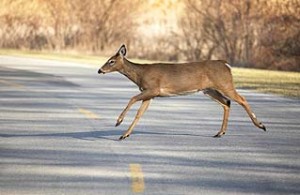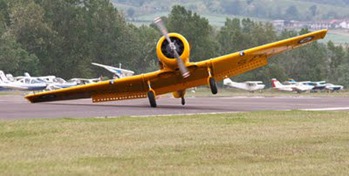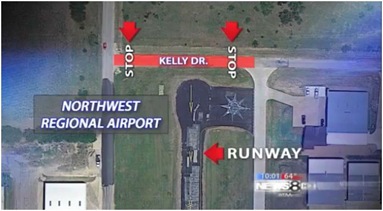There are two types of tailwheel pilots: Those who have ground-looped and those who (eventually) will…
Aircraft hits an SUV: Who’s fault was it?
In Roanoke (Texas) over the weekend, a single-engine plane clipped a passing SUV while making a landing and the incident was caught on video by the wife of the pilot who was on the ground filming her husband doing a solo. Luckily, no one was seriously injured in the incident but both the aircraft and the SUV suffered extensive damage plus the student pilot decided to quit flying just four weeks before he would have received his private pilot’s license.
Apparently, the airport does not own the road in front of the runway and there is a stop sign there – or rather the word “STOP” is written on the road:
A local news station then aired this segment with an interview with the couple in the SUV, the pilot and his wife and the airport owners:
On You Tube, several commenters posted comments about displaced threshold and the fence being at the end of the runway. In other words, perhaps the pilot came in too low.
However, we want to ask readers what you think after watching the video: Irrespective of whether it’s a smart idea to have a road at the end of an active runway, was the pilot at fault in any way?
Piper Cherokee vs. Bambi leads to substantial damage
We have written about incidents involving emus, dogs, rabbits, wild pigs, turtles, bulls and even cat fish either running, hopping or slithering across runways but General Aviation news has recently mentioned an October 2010 National Transportation Safety Board (NTSB) accident report that involved a Piper Cherokee and a deer on a runway. According to the accident report, the flight was a cross country night flight with a student pilot and a CFI. After landing at the destination airport in Titutsville, Florida, the pair taxied back to the runway in order to practice more flying in a traffic pattern.
 However and as the aircraft was on a takeoff roll, the CFI noticed a deer (no doubt with the deer in the headlights look!) right in front of the aircraft on the centerline. Hence, the CFI took control of the aircraft as it began to climb and a loud bang was heard. After that, the left rudder pedal was looser than normal and there was no brake pressure in the left toe brake.
However and as the aircraft was on a takeoff roll, the CFI noticed a deer (no doubt with the deer in the headlights look!) right in front of the aircraft on the centerline. Hence, the CFI took control of the aircraft as it began to climb and a loud bang was heard. After that, the left rudder pedal was looser than normal and there was no brake pressure in the left toe brake.
Before attempting to make a landing, the CFI made a few low passes to confirm from the control tower that the left landing gear was damaged. When a final landing was attempted, the left wing hit the ground – resulting in substantial damage to the left wing spar but no human injuries. No word about the deer but since there was no mention of an obstruction on the runway when the Piper Cherokee came in for a landing, we can probably assume that Bambi survived!
Video: Cargo plane bounces on a road (missing spectators) before landing
Hat tip to David Cenciotti for finding and posting this video of a decommissioned C-160 Transall cargo plane touching down first on a road in front of the runway and then on the actual runway in Germany:
The 63,935-pound aircraft had obviously flown the approach too low only to bounce on the road before touching down again on the runway. Luckily, no one was injured as there were at least 1,000 people watching the aircraft, which is destined for the Wernigerode Air Museum, try to land at the Ballenstedt airfield.
Certainly, the incident shows the need to watch your approach when coming in to land – especially if you are landing a 32-ton aircraft!
Accident report faults pilot for severely damaging a Tiger Moth in Wales
Back in August, we noted the story of a Tiger Moth pilot who managed to walk away after clipping a tree and crash landing in Denbighshire in north-east Wales but now the official report by the Department for Transport’s Air Accident Investigation Branch is out about the incident and naturally the pilot does not come out looking very good in it.
 To recap, the pilot had phoned a local named Pam, also a member of the Mold Camera Club, to ask who owned a field next to hers and whether he could use it to land. He later did a fly by of the field, flew a little lower for a second look and on the third attempt, clipped some trees because he could not pull up due to powerlines.
To recap, the pilot had phoned a local named Pam, also a member of the Mold Camera Club, to ask who owned a field next to hers and whether he could use it to land. He later did a fly by of the field, flew a little lower for a second look and on the third attempt, clipped some trees because he could not pull up due to powerlines.
According to the official accident report as noted by the Wales Air Forum, the unnamed pilot had identified the field as a possible landing site three years earlier and he walked it twice on the morning of the accident which made him aware that it would be a difficult landing site approximately 200 yards long that steeply sloped upwards for its first half and less steeply for the second half. Moreover and at the northern end of the field, there was a “small earth bank, a low fence, two trees and power and telephone lines.” Hence:
It was evident to him any go-around decision would need to be made in good time and would require careful flying to avoid the wires and trees.
However as the pilot had recently completed a lengthy series of flights and had a good deal of recent flying practice he was confident a safe landing could be made.
When the incident happened, the pilot made a flypast and an initial approach that had to be abandoned because the aircraft was too fast. On the second attempt, the pilot crossed a hedge but he also became aware that he was not only too fast to safely land, he was also too low to climb above the obstacles at the other end of the field. Hence, he opened the throttle to maintain flying speed and fly between the trees but while concentrating on flying through the space between the fence and the wires, he instead hit tree branches with the aircraft’s right wing tip.
According to the accident report:
The pilot observed the choice of landing site was not a good one and he had not adhered to his own pre-flight plan to go-around if the approach was not entirely satisfactory.
Of course his observation was made after he severely damaged a 73-year old aircraft and nearly killed himself along with the mother of Pam who was standing in the spot he crashed a few moments before. No word on when or whether the aircraft will be flying again – along with the pilot…
Flight simulators: Useless for practicing landings?
Paul Bertorelli has recently written an interesting post (Johnny Can Read, But He Can’t Land) for AVWeb covering landings that brought up some interesting points about the use of flight simulators to practice landings and whether they do a good or bad job of simulating one. Paul began by writing that landing an aircraft may not be particularly difficult but doing it well consistently isn’t easy either and year after year, this inconsistency gets reflected in the NTSB accident database. He also noted the greater use of flight simulators as a primary teaching tool.
However and for landings, Paul is not so sure how useful flight simulators are because:
Of all the tasks in flying, landing requires the most refined motor skills and hand-eye coordination in reaction to a stream of subtle cues. Some LSAs require more of that rather than less.
Paul then went on to mention that when he was at Oshkosh last summer, Jerry Gregoire put him into Redbird’s J-3 simulator which got the flight dynamics mostly right but it did not bounce on the runway the way a real Cub aircraft would.
And without the bounce dynamic built in, Paul concluded that you don’t have a flight simulator but rather just a video game because not all bounces are the same as the “small ones you get on a three-pointer can be ignored, but the 10-footers with roll excursions have to be dealt with aggressively.”
He also added that:
What separates an acceptable landing from one that’s bound for the ditches are often subtle cues related to seat-of-the-pants sensing of acceleration, turning and slipping moments. You feel these in your butt or see them through the windshield and you respond with the appropriate control input. Sometimes that’s gentle and subtle, sometimes not. But the airplane moving in three dimensions helps you discern the difference.
Flight simulators may get close to that but Paul concluded that they don’t yet nail it just yet.
Hence, we want to see what you our readers think about flight simulators in general along with simulated landings: In other words, do flight simulators do a good job of simulating landings just yet? Moreover, did flight simulators help you become a better general aviation pilot while training?


